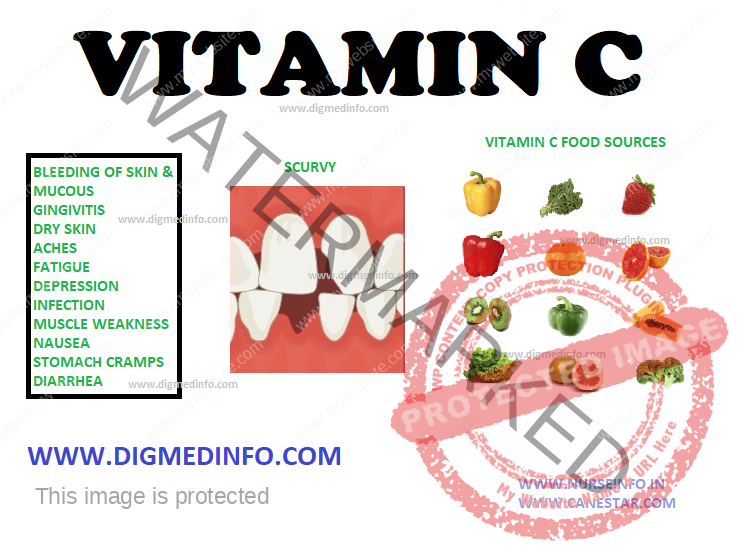ASCORBIC ACID – SCURVY (ANTISCORBUTIC VITAMIN – VITAMIN C)
James Lind, a Scottish naval physician, recognized the antiscorbutic properties of citrus fruits in 1753 and this was considered an important discovery with far-reaching effects.
Dietary sources Ascorbic acid is present in a wide variety of foods. In the process of cooking about 50% of vitamin C passes into water and 20% gets destroyed. Fresh fruits, green leafy vegetables and germinating pulses are rich in ascorbic acid. The Indian gooseberry and guavas are particularly rich sources. Animal food like milk and meat contain only small amounts of this vitamin. The vitamin is present in potato in the layer just below the skin. If the potatoes are boiled whole with the skin, the vitamin diffuses into the deeper layers.
The minimum daily requirement for an adult is 30-40 mg and for infants 5 mg per kg body weight. Normal plasma levels vary between 0.7 and 1.5 mg per dL. Leukocytes, platelets, and adrenal glands contain large amounts of vitamin C. Deficiency of vitamin C causes scurvy.
Physiological actions
Vitamin C is a strong reducing agent. It takes part in biological oxidation-reduction reactions. Vitamin C is required for the formation of collagen by the hydroxylation of proline. It takes part in the formation of hemoglobin, erythrocyte maturation and the conversion of folic acid to tetrahydrofolate. Ascorbic acid reduces ferric iron to ferrous iron which is more easily absorbed. Body stores of ascorbic acid are small and, therefore, dietary deficiency leads to the development of scurvy.
SCURVY
Deficiency of vitamin C in the diet over a few weeks or months will lead to scurvy.
Clinical features of scurvy
Classic scurvy is seen only infrequently in India since small amounts of vitamin C are obtained in vegetables and pickled berries which form essential items of the Indian diet. Cases do occur among inmates of mental homes, elderly persons and among the very poor.
Manifestations of scurvy vary in children and adults. Early symptoms include weakness, lassitude, and normocytic normochromic anemia. In infancy and childhood subperiosteal hemorrhages occur, which lead to painful swellings over long bones. Scurvy in infancy produces pseudoparalysis owing to pain. This condition may mimic arthritis, osteomyelitis, or poliomyelitis. X-ray abnormalities may develop over the sternal ends of ribs and ends of long bones. Bleeding from the gums occurs commonly at the sites of erupted teeth.
Retrobulbar, subarachnoid, and cerebral bleeding may develop in a few cases. In adults early manifestation is follicular hyperkeratosis over the skin of the lower limbs. The lesions are papular with perifollicular hemorrhages which appear as purpura. Hemorrhage into the deep tissues of the thighs and legs cause tense induration (“woody leg”). Other sites of hemorrhage include joints, nail beds and viscera. The gums are hypertrophied and the interdental papillae are red and prominent (scurvy-buds). They bleed easily. Edentulous subjects do not get gingival abnormalities. The gum changes are aggravated by infection. The teeth become loose and may fall off. The hair assumes corkscrew shape since the follicles are obstructed by keratin plugs. Wound healing is delayed and resistance to infection is reduced. The condition is fatal if untreated.
Treatment
Scurvy is a potentially fatal disease and sudden death may occur unexpectedly. Treatment should be started without delay. In infants and children 25-50 mg of ascorbic acid given daily three times a day is sufficient to replete the body stores. In adults 500 mg is given daily in divided doses up to a total of 4 g. A diet rich in vitamin C should be given to prevent relapse.
Prevention
Infant foods should contain fruit juices or vitamin C supplements. Children, convalescent subjects and elderly people who are liable to be neglected, should receive 25 mg of vitamin C daily. As an alternative, 500 mg may be given once a month.
Adverse effects of vitamin C
Side effects like digestive upsets and hypoglycemia occur if the drug is given in doses exceeding 3 g/day. Oxaluria and oxalate stone formation in the urinary tract may result from prolonged overdosage.


